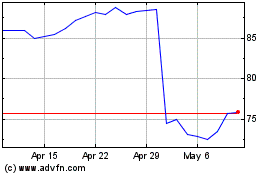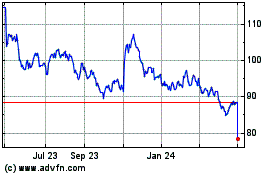New captain Kevin Johnson is tasked with turning around the
coffee giant's fortunes at home
By Julie Jargon
Kevin Johnson, the tech-industry executive who officially takes
over Monday as the chief executive of Starbucks Corp., inherits a
company facing its most prolonged slowdown in the U.S. since the
recession.
For more than six years, Starbucks had been posting quarterly
same-store sales growth of 5% or greater in its biggest market. But
that changed last year when it began missing analysts' sales
targets. The company last year blamed everything from uncertainty
about the outcome of the presidential election and weak consumer
confidence to disruption brought on by changes in its loyalty
program.
Then, in January, the coffee chain said a mobile-order app
created to reduce long lines at the cash register caused congestion
at the drink handoff area of some cafes -- leading customers to
forgo a Starbucks run upon seeing crowded stores and causing the
chain to miss sales expectations again. The chain lowered its
revenue forecast for the year.
As Howard Schultz, the CEO who built Starbucks into a global
coffee chain, steps down to focus on developing luxury coffee shops
within the company, Mr. Johnson has to make good on Starbucks'
promise to restore the U.S. business to its historic growth levels
of at least 5% increases in same-store sales.
Starbucks shares fell sharply following the announcement of the
CEO change, but they soon returned to where they had previously
been trading. Some Wall Street analysts have expressed reservations
about whether Mr. Johnson has the right background to steer a
large, global retail business, but others have said his time
running daily operations at Starbucks has prepared him well.
The 56-year-old former Microsoft executive and Juniper Networks
Inc. CEO has been on the Starbucks board since 2009 and has served
as the coffee chain's operating chief for the last two years,
before being tapped to take the top job late last year.
The WSJ sat down with Mr. Johnson in his office adjacent to Mr.
Schultz's to talk about the CEO handoff, the slowdown in U.S. sales
and why he doesn't plan to back away from taking a stand on social
issues, despite recent backlash from a refugee-hiring
announcement.
Here are edited excerpts of the interview:
WSJ: How much autonomy will you have as CEO?
Mr. Johnson: Howard has been clear that I'll be the CEO, so that
means the buck stops with me, but I am also smart enough to know
that you collaborate with people to get their input on things. So
will I talk to Howard about things that I am noodling on? Of
course.
WSJ: Transactions were down in the last quarter due to
congestion caused by customers picking up their mobile orders. What
are you doing to fix that?
Mr. Johnson: In some of those stores we've added a dedicated
barista who's greeting those customers and handing them their food
and beverage as they come in the door. That's alleviating some of
the congestion. We've also launched some new technology that gives
a customer who orders on their mobile app a notification when their
food and beverage is ready.
WSJ: Even before the latest issue with the mobile orders, growth
in the U.S. had been slowing. What is behind that?
Mr. Johnson: Well, I think if you look at the growth that we've
experienced over the last two years, we were posting very high
comp-store sales the prior year, so one of the factors is we're up
against significant growth from the prior year. The entire
restaurant industry is seeing a slowdown in growth, so there's
probably some that's related to that. We're very optimistic for the
long term, but it requires continuous innovation.
WSJ: You're trying to get bigger into lunch with a new menu of
freshly made food launching in Chicago this month. Why lunch?
Mr. Johnson: We already have a significant number of customers
coming to Starbucks at lunch for a beverage. Our thought is, if we
have fresh food that pairs well with the beverages customers are
buying at lunch, we'll sell more food items at lunch.
WSJ: How much more room is there to expand in the U.S.?
Mr. Johnson: A lot of growth opportunities might be in less
urban places, more suburban areas, the Midwest. Over the next five
years we've projected building 12,000 additional stores globally,
taking us to 37,000 stores. More than half of those stores will be
in the U.S. and China.
WSJ: When do you think China will overtake the U.S. as your
largest market?
Mr. Johnson: Not in the next five years, but you could do the
math and say in the next 10, 15 years.
WSJ: Howard has never been shy about voicing his opinion on
social issues, and his recent pledge to hire refugees was met with
backlash. Do you think taking a stand on certain social issues
could hurt the company?
Mr. Johnson: If it's driven by our principles, I think it helps
the company. Many of our veterans had worked with interpreters in
Iraq and Afghanistan that are now refugees and so we saw that as
very much aligned to the work we did hiring veterans. It helps us
attract great talent, but it also shows that we care about helping
create opportunities for people.
WSJ: Do you think you'll be as public as Howard when it comes to
speaking out on issues?
Mr. Johnson: I expect him to continue to be a spokesperson for
us but that doesn't mean that I won't be playing a role in
that.
WSJ: Why not just sell coffee?
Mr. Johnson: One of the reasons people come to work at Starbucks
is because we stand for something. It's about human connection and
having a sense of humanity. We think that's part of what makes
Starbucks a special place that both partners and customers want to
be associated with. And frankly, I think there should be more
publicly traded companies that also think about not only creating
shareholder value but how to contribute in a positive way to
society.
Write to Julie Jargon at julie.jargon@wsj.com
(END) Dow Jones Newswires
April 03, 2017 02:47 ET (06:47 GMT)
Copyright (c) 2017 Dow Jones & Company, Inc.
Starbucks (NASDAQ:SBUX)
Historical Stock Chart
From Mar 2024 to Apr 2024

Starbucks (NASDAQ:SBUX)
Historical Stock Chart
From Apr 2023 to Apr 2024
